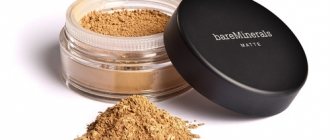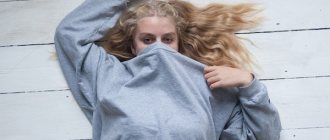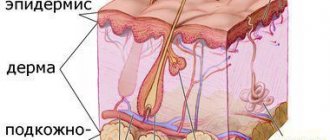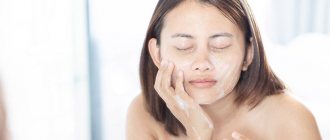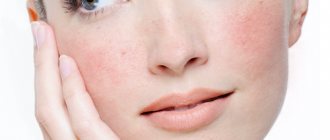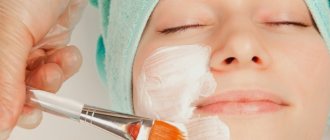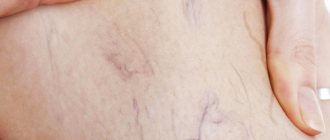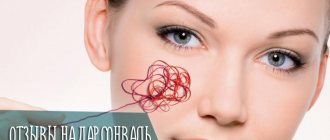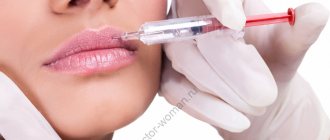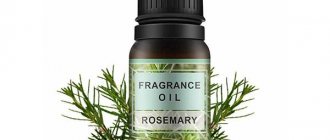Cuperosis
Clean and beautiful skin can be called an indicator of the overall health of the body. More often, pathological disease of internal organs is projected, primarily on the face. For example, rosacea is a disease of the blood capillaries. As a result, a vascular network appears on the cheeks, chin and wings of the nose. Most often the disease occurs in women. The vascular wall also often appears on the surface due to a sharp change in temperature conditions. In case of blood pressure disorders. Causes of vascular disorders (rosacea) - in women, it is possible with fluctuations in hormonal levels, pregnancy, taking glucocorticosteroids or contraceptives.
Other causes of vascular disorders:
- sudden changes in temperature;
- alcohol abuse;
- intense physical activity;
- poor diet (irritating spicy foods);
- stress.
Couperosis is often inherited
To prevent illness. To avoid the consequences of rosacea, you need to take a number of preventive measures. First of all, to avoid external factors that provoke the development of the disease in the first place.
First of all, this is a HEALTHY LIFESTYLE (HLS)!!!
Take preventive measures: massage treatments, walks in the fresh air, taking vitamins and medications to strengthen the vascular wall. Also, once a year, a biochemical blood test and blood pressure check by a therapist. Hereditary vascular disease is very common; it is difficult to influence a genetic disease. But, here too it is necessary to take preventive measures. Which a phleblogist can prescribe for you and thereby prevent the development of pathologies. During the off-season periods (spring and autumn), try to avoid exposure to sunlight by applying SPF protection to your facial skin.
In our clinic, you can be offered several options for the prevention and treatment of rosacea, or a comprehensive solution to the problem, such as:
- Laser treatment.
- Meso therapeutic techniques.
- Hardware methods for treating rosacea.
- Massage treatments.
Our doctors will select the best method for you, taking into account your characteristics.
Couperosis on the face: treatment with folk remedies at home.
The most proven and effective way to treat and prevent rosacea is cold tea lotions made from lightly brewed black tea. Just 15 minutes 2 times a day for a week will allow you to feel a noticeable effect. Do not use ice to wipe your face, as this can lead to hypothermia of the skin, vasospasm and compensatory dilation of neighboring capillaries, which will increase the manifestations of rosacea.
The herbal mask is made up of calendula, chamomile, horsetail, yarrow and horse chestnut flowers. Equal parts of each component are mixed with boiling water until a thick paste is formed and infused for ten minutes. Then the resulting slurry is cooled and applied to a gauze mask, which is placed on the face. After 15 minutes, the mask is washed off with a decoction of chamomile or yarrow.
This is just a small part of our secrets.
You can get more detailed advice from your cosmetologist. Dermatologist, cosmetologist: Lachinova Natalya Mikhailovna
What are the possible side effects from lasers and light treatments?
Redness is common after treatment. This usually disappears within 2 weeks. You may also see a rash of purple or red spots. They also usually go away within 1-2 weeks. During treatment, some patients experience skin tightness, itching, or pain. In skillful hands, scars are rare. While sun protection instructions may seem unnecessary, sun protection is really important. Stay out of the sun and protect your skin from sun damage to prevent permanent scars.
Cuperosis
What basic cosmetic procedures are used to treat rosacea?
If telangiectasia is severe, an impressive arsenal of therapeutic and cosmetic procedures comes to the rescue, which are selected based on the patient’s individuality. These primarily include:
Electrocoagulation. This is cauterization of blood vessels using a hair electrode. In this way, it is possible to eliminate even quite obvious manifestations of the disease. However, in some cases, electrocoagulation leaves scars or pigment spots on the skin.
Mesotherapy and biorevitalization. This method is based on microinjections of drugs that strengthen capillary walls and have a positive effect on blood microcirculation. This procedure can be performed for both treatment and prevention purposes.
Treatment of rosacea with laser. Laser therapy for rosacea is the cauterization of a pronounced vascular pattern using a laser beam. Thanks to its excellent results and almost complete absence of pain, laser is one of the most popular assistants in the treatment of telangiectasia.
Phototherapy. Treatment with light flashes is excellent for treating large-scale telangiectasias, and in addition, eliminates pigment spots, acne and other skin defects.
Therapeutic plastic massage. As opposed to traditional massage, which is harmful for telangiectasia, this procedure successfully copes with the manifestations of the disease, and in addition, is used for prevention.
Microdermabrasion
Microdermabrasion is a method of removing the top layer of skin, leaving it supple and radiant. Microdermabrasion wands with diamond tips remove this layer of skin. Gently exfoliating the skin with natural diamond chips. At the same time, the vacuum cleaner removes dead skin cells in a sterile and controlled manner. Removing this outer layer of dead skin cells leaves a smoother texture. Which promotes the growth of new healthy skin cells. Cuperosis treatment of blood capillary disease.
TRIGGERS FOR COUPEROSIS
- Sun rays.
- Hot or cold temperatures wind.
- Stress.
- Hot baths.
- Hot or spicy food or drinks.
- Alcohol.
- Intense exercise.
- Medicines, such as blood pressure medications or steroids, that you apply to your skin.
Couperose and redness
Red skin is not necessarily a sign of a skin problem. But that doesn't make her any less annoying. Redness can be caused by irritants, sun exposure, and insect bites. Or numerous diseases, but can also be a symptom of rosacea. This disease affects approximately 14 million Russians. Most often found in middle-aged women with fair skin. May be acute or chronic. Disappear and reappear over time and vary in intensity. If left untreated, rosacea can get worse over time, with new flare-ups becoming more intense. Treat both generalized redness and rosacea with a range of cosmetic treatments. These options will help minimize redness and improve skin tone and texture. Cuperosis treatment of vascular disorders on the cheeks and chin.
COMMON SYMPTOMS OF COUPEROSIS
- Redness on the face
- Small bumps filled with pus
- Swollen, red bumps
- Eye problems such as dryness and irritation.
- In some cases, thickening of the skin of the nose (most often in men)
If you have rosacea or just localized redness. Stimulating the skin will help improve discoloration and clear the complexion.
Are there characteristic concomitant diseases with rosacea?
The food triggers associated with rosacea are similar to those present with rosacea.
“These are hot tea and coffee, strong alcohol, food products containing capsaicin (spices, hot peppers, etc.) and cinnamaldehyde (chocolates, tomatoes, citrus fruits and other products),” Nadezhda Zhurbina lists. “In addition, by studying the etiological factors and assessing the clinical manifestations of the disease, it is quite possible to conclude that this condition is similar to rosacea.”
Couperosis and rosacea actually have many common features: many experts even believe that rosacea represents the next stage in the development of rosacea. However, with rosacea, both small and large capillaries are affected, while with rosacea, only small ones are affected. At the same time, manifestations of rosacea - especially early ones - indicate a general predisposition of the patient to vasodilation. This increases the risk of certain “related” problems occurring in the future - from varicose veins to stroke: during the treatment of rosacea, the prevention of these diseases should also be given increased attention.
TREAT COUPEROSIS IN ONE SESSION
Intense Pulsed Laser Light (IPL). Intense pulsed light or photorejuvenation is a device that emits light at different wavelengths. Therefore, can treat a wider range of skin problems. The IPL device was created to treat various skin conditions. Defining IPL can help you understand better. Why laser may be the best treatment for your combination of skin problems. A series of four to six IPL treatments can significantly reduce facial redness. The skin becomes redder in just a few hours.
Cuperosis
No skin damage, no wound care required. And there is no need to change your normal daily routine or activities. Regular treatments at varying intervals help maintain your results. The laser treatment procedure can remove some brown spots from sun damage as well as redness. Several small studies have used lasers to treat persistent facial redness. Or redness around pimples that look like pimples. Some patients experienced a significant reduction in redness. However, in most patients the redness decreased by about 20% of the rosacea.
On which parts of the body does rosacea most often occur?
“In most cases, rosacea is noted on the face, nose and neck, mainly in the cheekbones and on the wings of the nose,” says Nadezhda Zhurbina. — In general, this pathology does not affect a person’s health, but it significantly spoils the overall quality of life, since it is a very pronounced defect of a cosmetic nature. Moreover, in some cases, the capillary loops have such a distinct color that it is almost impossible to eliminate it through cosmetic correction.”
pexels.com/
Are there preventive measures against rosacea and what are they?
An excellent preventative measure against rosacea is the above-mentioned diet (hot spices, hot foods, coffee and alcohol, etc. should be removed from the diet, and bad habits should be avoided). Preventive mesotherapy using vascular-strengthening drugs, taking vitamins C and P and herbal herbal remedies (horse chestnut, rose hips, etc.) are also appropriate.
pexels.com/
Home skin care should be based on moisturizing and protecting it: essentially, a moisturizer will be the best cream for rosacea, and reviews from numerous patients who have experienced telangiectasia confirm this. At the same time, these products must be used indoors, and every time before going outside, you need to apply a protective cream.
